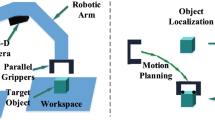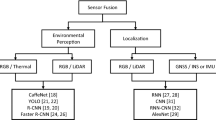Abstract
The assembly operation using industrial robots can be accomplished successfully in well-structured environments where the mating pair location is known in advance. However, in real-world scenarios there are uncertainties associated to sensing, control and modelling errors that make the assembly task very complex. In addition, there are also unmodeled uncertainties that have to be taken into account for an effective control algorithm to succeed. Among these uncertainties, it can be mentioned disturbances, backlash and aging of mechanisms. In this paper, a method to overcome the effect of those uncertainties based on the Fuzzy ARTMAP artificial neural network (ANN) to successfully accomplish the assembly task is proposed. Experimental work is reported using an industrial 6 DOF robot arm in conjunction with a vision system for part location and wrist force/torque sensing data for assembly. Force data is fed into an ANN evolving controller during a typical peg in hole (PIH) assembly operation. The controller uses an incremental learning mechanism that is solely guided by the sensed forces. In this article, two approaches are presented in order to compare the incremental learning capability of the manipulator. The first approach uses a primitive knowledge base (PKB) containing 16 primitive movements to learn online the first insertion. During assembly, the manipulator learns new patterns according to the learning criteria which turn the PKB into an enhanced knowledge base (EKB). During a second insertion the controller uses effectively the EKB and operation improves. The second approach employs minimum information (it contains only the assembly direction) and the process starts from scratch. After several operations, that knowledge base increases by including only the needed patterns to perform the insertion. Experimental results showed that the evolving controller is able to assemble the matting pairs enhancing its knowledge whenever it is needed depending on the part geometry and level of expertise. Our approach is demonstrated through several PIH operations with different tolerances and part geometry. As the robot’s expertise evolves, the PIH operation is carried out faster with shorter assembly trajectories.


















Similar content being viewed by others
References
Angelov P, Filev D, Kasabov N (2010) Evolving intelligent systems: methodology and applications. IEEE Press Series on Computational Intelligence. Willey
Asada H (1990) Teaching and learning of compliance using neural nets. IEEE Int Conf Robot Autom. pp 1237–1244
Baek J, Lee H, Lee B, Lee H, Kim E (2014) An efficient genetic selection of the presentation order in simplified fuzzy ARTMAP patterns. Appl Soft Comput. vol 22, pp 101–107
Bruzzone LE, Molfino RM, Zoppi M (2002) Modelling and control of peg-in-hole assembly performed by a translational robot. In: Proceedings of the International Conference Modeling Identification and Control, Austria, pp 512–7
Carpenter GA, Grossberg S, Markunzon N, Reynolds JH, Rosen DB (1992) Fuzzy ARTMAP: a neural network architecture for incremental learning of analog multidimensional maps. IEEE Trans Neural Netw 3(5):698–713
Chen Y, Han X, Okada M, Chen Y, Naghdy F (2007) Intelligent robotic peg-in-hole insertion learning based on haptic virtual environment. In: Computer-Aided Design and Computer Graphics, 2007 10th IEEE International Conference on, pp 355–360
Cervera E, del Pobil AP (1996) Learning and classification of contact states in robotic assembly tasks. In: Proceedings of the 9th International Conference on IEA/AIE, pp 725–730
Cervera E, del Pobil AP (1997) Programming and learning in real-world manipulation tasks. In: IEEE/RSJ International Conference on Intelligent Robot and Systems, pp 471–476
Duan F, Tan JTC, Zhang Y, Watanabe K, Pongthanya N, Sugi M, Arai T (2007) Analyze assembly skills using a motion simulator. In: Robotics and Biomimetics, 2007. ROBIO 2007. IEEE International Conference on, pp 1428–1433
Gama J, Aguilar J (2007) Knowledge discovery from data streams. Intell Data Anal. vol 11, pp 1–2
Gonçalves PJS, Lopes PJF, Torres PMB, Sequeira JMR (2013) Evolving fuzzy uncalibrated visual servoing for mobile robots. Comput Intell Decis Making. pp 57–68
Gullapalli V, Franklin JA, Benbrahim H (1994) Acquiring robot skills via reinforcement learning. IEEE Control Systems. pp 13–24
Howarth M (1998) An investigation of task level programming for robotic assembly, Ph.D. Thesis, The Nottingham Trent University
Huang L, Song Q, Kasabov N (2005) Evolving connectionist systems based role allocation of robots for soccer playing. Intelligent Control, 2005. In: Proceedings of the 2005 IEEE International Symposium on, Mediterrean Conference on Control and Automation, pp 36–40
Huang S, Aertbelien E, Bruyninckx H, VanBrussel H (2013) Behavior based task learning by demonstration for mobile manipulators. Int J Autom Smart Technol 3(1):19–28
Kasabov N, Filev D (2006) Evolving intelligent systems: methods, learning, & applications. Evolving Fuzzy Systems. In: 2006 International Symposium on, pp 8–18
Kasabov N (2007) Evolving connectionist systems: the knowledge engineering approach. Springer, Berlin
Klaus G, Glette K, Høvin M (2013) Evolving locomotion for a 12-DOF quadruped robot in simulated environments. Biosystems 112(2):102–106
Nedev DG, Haasdijk E et al (2014) Controlling maximum evaluation duration in on-line and on-board evolutionary robotics. Evolving Systems, pp 1–12
Xu J, He H, Man H (2012) DCPE co-training for classification. Neurocomputing, vol 86, pp 75–85
Yun SK (2008) Compliant manipulation for peg-in-hole: is passive compliance a key to learn contact motion? In: Robotics and Automation, 2008. ICRA 2008. IEEE International Conference on, pp 1647–1652
Acknowledgments
Authors want to acknowledge CONACyT for Mr. Navarro Gonzalez’s scholarship to pursue his doctoral studies.
Author information
Authors and Affiliations
Corresponding author
Rights and permissions
About this article
Cite this article
Navarro-Gonzalez, J.L., Lopez-Juarez, I., Ordaz-Hernandez, K. et al. On-line incremental learning for unknown conditions during assembly operations with industrial robots. Evolving Systems 6, 101–114 (2015). https://doi.org/10.1007/s12530-014-9125-x
Received:
Accepted:
Published:
Issue Date:
DOI: https://doi.org/10.1007/s12530-014-9125-x




